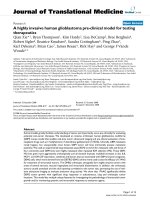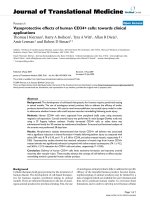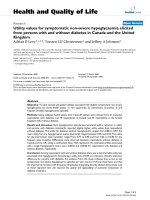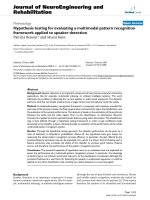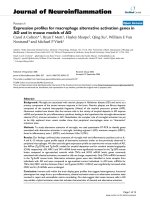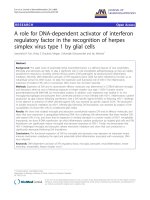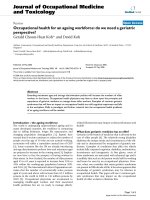Báo cáo hóa học: " Plaque assay for human coronavirus NL63 using human colon carcinoma cells" ppt
Bạn đang xem bản rút gọn của tài liệu. Xem và tải ngay bản đầy đủ của tài liệu tại đây (1.58 MB, 9 trang )
BioMed Central
Page 1 of 9
(page number not for citation purposes)
Virology Journal
Open Access
Methodology
Plaque assay for human coronavirus NL63 using human colon
carcinoma cells
Petra Herzog
1,3
, Christian Drosten*
2
and Marcel A Müller
2
Address:
1
Bernhard Nocht Institute for Tropical Medicine, Bernhard-Nocht-Str. 74, D-20359 Hamburg, Germany,
2
Institute of Virology, University
of Bonn Medical Centre, Sigmund-Freud-Str. 25, 53127 Bonn, Germany and
3
Qiagen Hamburg GmbH, Königstr. 4a, D-22767 Hamburg, Germany
Email: Petra Herzog - ; Christian Drosten* - ; Marcel A Müller -
* Corresponding author
Abstract
Background: Coronaviruses cause a broad range of diseases in animals and humans. Human
coronavirus (hCoV) NL63 is associated with up to 10% of common colds. Viral plaque assays enable
the characterization of virus infectivity and allow for purifying virus stock solutions. They are
essential for drug screening. Hitherto used cell cultures for hCoV-NL63 show low levels of virus
replication and weak and diffuse cytopathogenic effects. It has not yet been possible to establish
practicable plaque assays for this important human pathogen.
Results: 12 different cell cultures were tested for susceptibility to hCoV-NL63 infection. Human
colon carcinoma cells (CaCo-2) replicated virus more than 100 fold more efficiently than
commonly used African green monkey kidney cells (LLC-MK2). CaCo-2 cells showed
cytopathogenic effects 4 days post infection. Avicel, agarose and carboxymethyl-cellulose overlays
proved suitable for plaque assays. Best results were achieved with Avicel, which produced large and
clear plaques from the 4
th
day of infection. The utility of plaque assays with agrose overlay was
demonstrated for purifying virus, thereby increasing viral infectivity by 1 log 10 PFU/mL.
Conclusion: CaCo-2 cells support hCoV-NL63 better than LLC-MK2 cells and enable
cytopathogenic plaque assays. Avicel overlay is favourable for plaque quantification, and agarose
overlay is preferred for plaque purification. HCoV-NL63 virus stock of increased infectivity will be
beneficial in antiviral screening, animal modelling of disease, and other experimental tasks.
Background
Coronaviruses are large enveloped plus-strand RNA
viruses that are currently classified in three groups or pre-
sumptive genera [1-3]. Group 1 is further divided into two
phylogenetic clades exemplified by the transmissible gas-
troenteritis virus (TGEV) and the porcine epidemic diar-
rhoea virus (PEDV), respectively. The latter clade contains
two prototypic human coronaviruses (hCoV), termed
hCoV-229E and -NL63 [4,5]. Like group 1, group 2 con-
tains mammalian CoV. These include two human patho-
genic prototypes, termed hCoV-OC43 and -HKU1, several
important animal pathogens such as the bovine CoV and
the murine hepatitis virus, as well as the SARS-CoV [6-8].
Group 3 contains foremostly avian CoV [9].
HCoV-229E and OC43 as well as the more recently iden-
tified hCoV-HKU1 and – NL63 are major causes of com-
mon colds in wintertime [10]. HCoV-NL63 was isolated
in African green monkey kidney cells (LLC-MK2) from a
seven month old infant with bronchiolitis and conjuncti-
Published: 12 November 2008
Virology Journal 2008, 5:138 doi:10.1186/1743-422X-5-138
Received: 22 October 2008
Accepted: 12 November 2008
This article is available from: />© 2008 Herzog et al; licensee BioMed Central Ltd.
This is an Open Access article distributed under the terms of the Creative Commons Attribution License ( />),
which permits unrestricted use, distribution, and reproduction in any medium, provided the original work is properly cited.
Virology Journal 2008, 5:138 />Page 2 of 9
(page number not for citation purposes)
vitis [4]. In further investigations the virus was predomi-
nantly detected in children with respiratory infections
[11-14]. Up to 10% of children with respiratory disease
yielded hCoV-NL63 [10,11,15-17].
Because of its relatively high prevalence hCoV-NL63 could
become an important model in screening for anti-corona-
viral agents [12,18]. Several studies have suggested, e.g.,
that hCoV protease inhibitors would be cross-reactive
among different hCoV [19-21]. Antiviral screening relies
on the detection of replicating virus in cell culture. For this
and other experimental tasks, plaque assays have proven
to be simple in application and efficacious in representing
virus viability.
Plaque assays make use of viscous overlays to cover cells
immediately after infection, thus limiting virus spread
and restricting virus growth to foci of cells at the sites of
initial infection. If virus contributes no or low cytopathic
effects to cells, these foci may be visualized by immunos-
taining [22,23]. If virus induces strong cytopathogenic
effects (CPE), cells in plaques are lysed and plaques can be
visualized by staining of the residual intact cells.
Cytopathogenic plaque assays are compatible with high
throughput screening [24,25] and facilitate plaque purifi-
cation and cloning of virus. This in turn is helpful in
obtaining virus stocks of optimized infectivity, e.g., by
decreasing the amount of defective interfering (di) parti-
cles that accumulate during serial passaging of CoV [26].
Important technical achievements have been made in
studying NL63 replication, including, most recently, the
development of an infectious cDNA clone [27]. Still it is a
major obstacle that hCoV-NL63 replicates slowly and at
relatively low titres in all current cell cultures, such as LLC-
MK2 and Vero-B4 cells [4,28,29]. Because the virus con-
tributes very weak and diffuse CPE to these cells, there is
no cytopathic plaque assay available for non-recombinant
virus [28].
Although hCoV-NL63 seems to replicate in the upper and
lower airways, there are many CoV that predominantly
infect the enteric tract, such as TGEV, PEDV, the feline
enteric CoV, and the bovine coronavirus [30,31]. SARS-
CoV was detected in faecal swabs from SARS patients [32].
SARS-CoV was shown to replicate in colon carcinoma
cells (CaCo-2) [33] that are routinely used for growing
entero- and adeno-, and astroviruses [34]. Interestingly,
SARS-CoV and hCoV-NL63 were shown to use the same
receptor for virus entry, the angiotensin converting
enzyme 2 (ACE2) [35].
We show here that CaCo-2 cells are highly susceptible for
hCoV-NL63 infections and that virus propagation in these
cells is much more efficient than in LLC-MK2 cells. By test-
ing different overlays and assay formats we developed
cytopathogenic NL63 plaque assays that can be used for
analytical and preparative purposes.
Results and discussion
Susceptibility of different cell lines to hCoV-NL63 and
cytopathogenic effects
LLC-MK2 and Vero cells do not cause clear CPE on infec-
tion with hCoV-NL63. Because this virus uses the same
receptor as the SARS-CoV, 12 different cell cultures sus-
ceptible to SARS-CoV infection were tested for susceptibil-
ity to hCoV-NL63 [34,36,37] (Table 1). Cells in six-well
plates were infected with 10e4 plaque-forming units of
Table 1: Comparison of hCoV-NL63 replication by real time RT-PCR using different cell cultures
Designation* Day 0 [copies/μL] Day 7 [copies/μL] Amplification factor Cytopathogenic effect (CPE)
Vero E6 6.94e3 3.05e7 4.39e3 None
Vero FM 1.78e4 4.51e9 2.54e5 None
CaCo-2 3.55e3 1.25e10 3.54e6 round and detached, dead cells with cell debris in
supernatant, strong effect
Calu1 2.61e4 5.33e6 2.04e2 None
Calu6 7.95e3 5.00e5 6.29e1 None
POEK 8.11e4 3.03e5 3.74e0 None
PK13 2.66e2 7.78e5 2.93e3 None
293lp 3.67e3 3.09e7 8.42e3 None
FeA 1.45e4 5.83e5 4.03e1 None
RD 3.14e5 1.57e4 4.99e-2 None
PS 1.20e4 1.44e6 1.19e2 None
LLC-MK2 4.00e3 2.65e6 6.62e2 round and detached, weak effect
* Vero E6 rhesus kidney cells (ATCC CRL-1586), Vero FM rhesus kidney cells (ATCC CCL-81), CaCo-2 human colon carcinoma (ATCC HTB-37),
Calu 1 human lung carcinoma (ICLC HTL95002), Calu 6 human lung carcinoma (ICLC HTL97003), POEK porcine foetal kidney (cell culture
collection of the Robert Koch-Institute (RKI), Berlin, Germany), PK13 porcine kidney (cell culture collection of the Bernhard-Nocht-Institute (BNI),
Hamburg, Germany), 293 human embryonic kidney (ATCC CRL-1573), FEA feline embryonic fibroblast (kindly provided by Dr. Marcel Asper,
NewLab Inc., Cologne), RD human rhabdomyosarcoma cells (RKI), PS porcine kidney cells (RKI), and LLC-MK2 African green monkey kidney cells
(ATTC CCL-7, kindly provided by Lia van der Hoek, Academic Medical Center Amsterdam, The Netherlands).
Virology Journal 2008, 5:138 />Page 3 of 9
(page number not for citation purposes)
hCoV-NL63 virus stock LLC-MK2 NP. RNA concentra-
tions in supernatants were measured short after virus
adsorption (i.e., in fresh medium after washing off of the
infection supernatant), and 7 days later (Table 1). Increase
of virus RNA was less than 1000-fold in seven of 12 cul-
tures. Interestingly, this included LLC-MK2, the prototype
cell culture for NL63. In spite of a low amplification factor
these cells showed the usual weak CPE that is typically
observed when infected with hCoV-NL63.
Vero cells seemed to support virus growth efficiently but
produced no CPE. Interestingly, there was a remarkable
difference between Vero E6 and Vero FM cells (Table 1).
In our hands these cells also showed differences in growth
of SARS-CoV. Vero FM consistently showed more pro-
nounced CPE than Vero E6 but there were no significant
differences in RNA amplification (not shown).
CaCo-2 cells amplified virus RNA most efficiently, and
showed a clearly visible CPE starting from day 4 after
infection. Cells became rounded, detached from the sur-
face, and showed morphological signs of cell death (Fig-
ure 1).
For confirmation of differential replication efficiencies,
CaCo-2 and LLC-MK2 cells were infected in parallel. Both
cell lines were seeded in 25 cm
2
flasks, and infected at
multiplicities of infection of 0.005. Samples of superna-
tants were taken daily from day 0 to 7 and analyzed by real
time RT-PCR. As shown in Figure 2, CaCo-2 cells repli-
cated virus more efficiently than LLC-MK2. From day 3
onward, RNA concentrations were more than 100 fold
higher in CaCo-2 cells. Because of the clear CPE observed
in CaCo-2 cells, these cells were tested for their utility in a
cytopathogenic plaque assay.
Comparison of different overlays
Three overlay techniques commonly used for plaque
assays were tested for their suitability [23]. CaCo-2 cells
were infected in 6-well plates with hCoV-NL63. After one
hour, supernatants were removed, cells washed with PBS,
and overlaid as follows.
For CMC overlays, 1 mL fresh DMEM was added to each
well. Subsequently 1 mL of 1.6% CMC solution was
slowly added per well. Agarose overlays (1% final concen-
tration) were prepared by melting 2% agarose at 70°C,
cooling it in a water bath to 42°C, and mixing it immedi-
ately before application with an equal volume of 2 ×
DMEM stored at room temperature. Two mL of the mix-
ture were carefully applied to each well. Avicel overlays
were made by mixing 2.4% Avicel solution with an equal
volume of 2 × DMEM. 2 mL of the mixture were immedi-
ately added to each well.
Plaque assays were incubated without disturbing at 37°C
and 5% CO
2
. Overlays were removed on day five and cells
were fixed with a solution of 4% formaldehyde in PBS.
After 30 min the formaldehyde solution was removed,
cells were washed twice with PBS, and stained with a 0.2%
crystal violet solution. As shown in Figure 3, plaques were
Cytopathogenic effect of hCoV-NL63 on human colon carcinoma cells (CaCo-2)Figure 1
Cytopathogenic effect of hCoV-NL63 on human colon carcinoma cells (CaCo-2). CaCo-2 cells 5 days after infec-
tion with hCoV-NL63 at an multiplicity of infection of 0.1 (agarose overlay technique). A, mock-infection; B, infection. Photo-
graphs were taken at 40-fold magnification; bars represent 20 μm.
Virology Journal 2008, 5:138 />Page 4 of 9
(page number not for citation purposes)
visible with all three overlays, but staining was clearest
with Avicel.
Incubation times
HCoV-NL63 culture with LLC-MK2 cells takes more than
7 days until first signs of weak CPE become visible. In
order to test whether incubation times could be reduced
with CaCo-2 cells, five plaque assays on virus dilution
series were done with Avicel overlays and terminated by
fixation after 1, 2, 3, 4, and 5 days, respectively. On days
1 and 2, no plaques were visible (not shown). Termina-
tion at day 3 yielded plaques only at high virus concentra-
tion (Figure 4). From day 4 onward, plaques were visible
in the lowest detectable virus concentration. Plaques on
day 5 were larger, but did not increase in number.
Plaque preparation
Work with hCoV-NL63 is complicated by low infectious
titers in virus stock solutions. In order to obtain more
infectious virus solutions, our standard virus stock LLC-
MK2 NP (see Materials and Methods section) was plaque-
purified using the agarose overlay. Because life staining of
cells with neutral red solution was not successful on
CaCo-2 cells (not shown), we used an alternative tech-
nique of plaque preparation.
Limiting dilution infections were done on 6-well plates.
After 5 days, cytopathic foci were identified by scanning
through the wells with an inverted microscope at low
magnification, lighting through the clear agarose overlay.
The positions of CPE foci were marked with a permanent
marker (it was helpful to turn up the microscope light for
this). The agarose overlay was penetrated with a pipette
and 10 to 20 μl of fluid was aspirated underneath the
overlay. This fluid was resuspended in 100 μl of Opti Pro
serum-free medium, which served as the starting solution
for a new limiting dilution infection series in the next 6-
well plate plaque assay. Three rounds of purification were
Growth kinetics of hCoV-NL63 on LLC-MK2 and CaCo-2 cellsFigure 2
Growth kinetics of hCoV-NL63 on LLC-MK2 and CaCo-2 cells. 25 cm
2
flasks of LLC-MK2 or CaCo-2 cells were
infected at multiplicities of infection of 0.005 for 1 h, washed twice with PBS, and subsequently supplied with 10 mL DMEM.
Samples were taken daily from day 0 to 7 (except day 4) and analyzed by real time RT-PCR. Error bars indicate ranges of three
independent experiments.
Virology Journal 2008, 5:138 />Page 5 of 9
(page number not for citation purposes)
done. After the last round, aspirated fluid was inoculated
in 5 mL of Opti Pro serum-free medium, which was then
overlaid on confluent CaCo-2 cells in a 25 cm
2
flask for
infection. After infection for one hour and washing, 5 mL
DMEM were added and flasks were incubated at 37°C,
5% CO
2
for four days. Stocks were harvested and stored as
described for the original LLC-MK2 stock in the Materials
and Methods section. The purified virus is hereafter
referred to as CaCo-2 PP (for plaque-purified).
To compare the infectivity of the plaque-purified virus
with the original LLC-MK2 virus stock (see Materials and
Methods section), viral titres were determined by Avicel
plaque assay as shown in Figure 5. CaCo-2 PP was about
10-fold more infectious than LLC-MK2 NP. Plaque assays
were repeated three times (not shown). Mean titres were
determined to be 1.4 × 10e6 PFU/mL and 1.3 × 10e5 PFU/
mL, respectively, for CaCo-2 PP and LLC-MK2 NP. Abso-
lute quantification of virus RNA by real-time RT-PCR
yielded 4.8 × 10e11 RNA copies/mL for CaCo-2 PP and
5.3 × 10e10 copies/mL for LLC-MK2 NP.
It was interesting to note that both virus stocks had rather
high RNA concentrations as opposed to their infectivities.
PFU/RNA ratios were 2.92 × 10e-6 for CaCo-2 PP and
2.45 × 10e-6 for LLC-MK2 NP. This high excess of RNA
over infectious units might be attributable to the virus
harvesting procedure, possibly releasing nonpackaged
RNA along with virus particles during freeze-thawing.
Because PFU/RNA ratios were very similar for both stocks,
it appeared unlikely that elimination of defective interfer-
ing particles had contributed the gain of infectivity. It will
be interesting in future studies to see whether hCoV-NL63
might have adapted to CaCo-2 cells during plaque purifi-
cation.
Conclusion
CaCo-2 cells seem to support hCoV-NL63 replication sig-
nificantly better than hitherto used culture cells. Their
application for a cytopathogenic plaque assay facilitates
quantification of infectivity and enables studies using
plaque morphology. Short incubation time of 4 days is
compatible with high-throughput applications such as
drug screening. The use of Avicel as an overlay is favoura-
ble for plaque quantification, whereas agarose overlays
are preferred for plaque purification. Virus stock of
increased infectivity will be beneficial for antiviral screen-
ing, animal modelling of disease, and other experimental
tasks.
Methods
Cell cultures
All cells were cultivated in DMEM (Dulbecco's Modified
Eagles Medium) (PAA, Cölbe, Germany) with 4.5 g/L Glu-
cose (PAA), supplemented with 10% Foetal Bovine Serum
"GOLD" (PAA), 1% Penicillin/Streptomycin 100 × con-
centrate (Penicillin 10000 U/mL, Streptomycin 10 mg/
mL) (PAA), 1% L-Glutamine 200 mM, 1% Sodium Pyru-
vate 100 mM (PAA), 1% MEM nonessential amino acids
(NEAA) 100 × concentrate (PAA). Utilized cell cultures are
identified in Table 1. For passaging, cells were detached
using trypsin-EDTA (PAA), except CaCo-2 cells. These
were routinely subcultured by scraping and pipetting for
mechanical re-suspension.
Plaque assay for hCoV-NL63 on CaCo-2 cells using different overlaysFigure 3
Plaque assay for hCoV-NL63 on CaCo-2 cells using
different overlays. HCoV-NL63 was serially diluted on
CaCo-2 cells (10e-1 until 10e-5). After 1 h of virus adsorb-
tion different overlays were added. After 5 days cells were
fixed with 4% formaldehyde and stained with 0.2% crystal
violet solution. A) carboxymethyl-cellulose; B) agarose; C)
Avicel.
Virology Journal 2008, 5:138 />Page 6 of 9
(page number not for citation purposes)
Plaque assays with different incubation timesFigure 4
Plaque assays with different incubation times. Plaque assays were performed with Avicel overlay and incubated for 3, 4,
and 5 days, respectively. The dilution factor of LLC-MK2 NP virus stock used for infection is shown on the bottom.
Virology Journal 2008, 5:138 />Page 7 of 9
(page number not for citation purposes)
Effect of plaque purificationFigure 5
Effect of plaque purification. A, plaque assay with Avicel overlay on purified virus stock CaCo-2 PP. B, plaque assay on non-
purified virus stock LLC-MK2 NP. C, viral RNA copies per mL of supernatant (left) and plaque forming units per mL of super-
natant (right) for CaCo-2 PP and LLC-MK2 NP virus stocks (log scale). Error bars show ranges of three independent experi-
ments.
Virology Journal 2008, 5:138 />Page 8 of 9
(page number not for citation purposes)
HCoV-NL63 virus stock solution
An eighth passage virus stock of hCoV-NL63 was kindly
provided by Lia van der Hoek, AMC Amsterdam. It was
grown in LLC-MK2 cells in limiting dilution series, recov-
ering it three times from the last well of a dilution series
still showing diffuse CPE. Subconfluent LLC-MK2 monol-
ayers were infected in 75 cm
2
flasks with virus supernatant
from the last round of limiting dilution culture at a ratio
of 1:100 (200 μl virus supernatant in 20 mL of fresh
medium). This concentration was the highest virus dilu-
tion still infectious in this culture format. The flasks were
incubated at 37°C, 5% CO
2
, and harvested on day four.
For harvesting, flasks were frozen at -70°C and thawed.
Cells and supernatant were centrifuged for 10 min at 5000
rpm. Cleared supernatant was aliquoted and stored at -
70°C. This virus stock is hereafter referred to as LLC-MK2
NP (for non-purified).
Infection of cells
Cells were seeded in 6-well plates at approximately 4 ×
10e5 cells per well and incubated until the monolayer was
70–80% confluent. CaCo-2 cells were grown to 100%
confluence. Prior to infection cells were washed with 1 ×
phosphate buffered saline (PBS). Virus inoculum in 900
μL GIBCO Opti Pro serum free medium (Invitrogen, Karl-
sruhe, Germany) plus 1% Penicillin/Streptomycin (PAA)
and 1% L-Glutamine (PAA) was added to each well. Inoc-
ulum was removed after one hour of incubation. Cells
were washed twice with 1 × PBS and supplemented with 2
mL DMEM per well.
RNA extraction and real time RT-PCR
Viral RNA was extracted from cell culture supernatant
with the QIAamp Viral RNA mini Kit (QIAGEN, Hilden,
Germany). Real time RT-PCR for hCoV-NL63 with abso-
lute virus RNA quantification was performed as described
previously [38].
Media and overlays for plaque assays
A 2.4% (w/v) suspension of Avicel RC-581 (FCM BioPol-
ymer, Brussels, Belgium) was prepared in distilled water
and autoclaved (20 min 121°C)[23]. A 2% (w/v) suspen-
sion of agarose (Plaque Agarose, Biozym, Hessisch Olden-
dorf, Germany) was prepared in distilled water and
autoclaved. A 1.6% carboxymethyl cellulose (CMC) solu-
tion was prepared by autoclaving CMC powder (BDH,
Poole, UK) with a magnetic stirrer. Autoclaved powder
was hydrated in DMEM at 1.6% (w/v) and stirred over-
night until homogenous.
Double concentrated Dulbecco's modified Eagle medium
(DMEM) was prepared by mixing DMEM (PAA) with 9.48
g/L DMEM Powder (Biochrom, Berlin, Germany), supple-
mented with 20% Foetal Bovine Serum "GOLD" (PAA),
2% Penicillin/Streptomycin 100 × concentrate (Penicillin
10000 Units/mL, Streptomycin 10 mg/mL) (PAA), 2% L-
Glutamine 200 mM, 2% Sodium Pyruvate 100 mM
(PAA), 2% MEM NEAA 100 × concentrate (PAA). Medium
was sterilized by filtration.
Competing interests
The authors declare that they have no competing interests.
Authors' contributions
PH performed the experiments and wrote the manuscript.
CD coordinated the experiments and wrote the manu-
script. MAM performed the experiments and wrote the
manuscript.
Acknowledgements
This study was supported by the German Ministry of Education and
Research (Project Code "Ökologie und Pathogenese von SARS"), and the
European Commission (contract SSPE-CT-2005-022639).
References
1. Masters PS: The molecular biology of coronaviruses. Adv Virus
Res 2006, 66:193-292.
2. Gorbalenya AE, Snijder EJ, Spaan WJ: Severe acute respiratory
syndrome coronavirus phylogeny: toward consensus. J Virol
2004, 78:7863-7866.
3. Gonzalez JM, Gomez-Puertas P, Cavanagh D, Gorbalenya AE,
Enjuanes L: A comparative sequence analysis to revise the cur-
rent taxonomy of the family Coronaviridae. Arch Virol 2003,
148:2207-2235.
4. Hoek L van der, Pyrc K, Jebbink MF, Vermeulen-Oost W, Berkhout
RJ, Wolthers KC, Wertheim-van Dillen PM, Kaandorp J, Spaargaren J,
Berkhout B: Identification of a new human coronavirus. Nat
Med 2004, 10:368-373.
5. Hamre D, Procknow JJ: A new virus isolated from the human
respiratory tract. Proc Soc Exp Biol Med 1966, 121:190-193.
6. Pyrc K, Berkhout B, Hoek L van der: Identification of new human
coronaviruses. Expert Rev Anti Infect Ther 2007, 5:245-253.
7. Kahn JS: The widening scope of coronaviruses. Curr Opin Pediatr
2006, 18:42-47.
8. Woo PC, Lau SK, Chu CM, Chan KH, Tsoi HW, Huang Y, Wong BH,
Poon RW, Cai JJ, Luk WK, et al.: Characterization and complete
genome sequence of a novel coronavirus, coronavirus
HKU1, from patients with pneumonia. J Virol 2005, 79:884-895.
9. Cavanagh D: Coronaviruses in poultry and other birds. Avian
Pathol 2005, 34:439-448.
10. Pyrc K, Berkhout B, Hoek L van der: The novel human coronavi-
ruses NL63 and HKU1. J Virol 2007, 81:3051-3057.
11. Dijkman R, Jebbink MF, El Idrissi NB, Pyrc K, Muller MA, Kuijpers TW,
Zaaijer HL, Hoek L van der: Human coronavirus NL63 and 229E
seroconversion in children. J Clin Microbiol 2008, 46:2368-2373.
12. Pyrc K, Berkhout B, Hoek L van der: Antiviral strategies against
human coronaviruses. Infect Disord Drug Targets 2007, 7:59-66.
13. Han TH, Chung JY, Kim SW, Hwang ES: Human Coronavirus-
NL63 infections in Korean children, 2004–2006. J Clin Virol
2007, 38:27-31.
14. Chiu SS, Chan KH, Chu KW, Kwan SW, Guan Y, Poon LL, Peiris JS:
Human coronavirus NL63 infection and other coronavirus
infections in children hospitalized with acute respiratory dis-
ease in Hong Kong, China. Clin Infect Dis 2005, 40:1721-1729.
15. Bastien N, Robinson JL, Tse A, Lee BE, Hart L, Li Y: Human coro-
navirus NL-63 infections in children: a 1-year study. J Clin
Microbiol 2005, 43:4567-4573.
16. Ebihara T, Endo R, Ma X, Ishiguro N, Kikuta H: Detection of
human coronavirus NL63 in young children with bronchioli-
tis. J Med Virol 2005, 75:463-465.
17. Moes E, Vijgen L, Keyaerts E, Zlateva K, Li S, Maes P, Pyrc K, Berkhout
B, Hoek L van der, Van Ranst M: A novel pancoronavirus RT-PCR
assay: frequent detection of human coronavirus NL63 in chil-
Publish with BioMed Central and every
scientist can read your work free of charge
"BioMed Central will be the most significant development for
disseminating the results of biomedical research in our lifetime."
Sir Paul Nurse, Cancer Research UK
Your research papers will be:
available free of charge to the entire biomedical community
peer reviewed and published immediately upon acceptance
cited in PubMed and archived on PubMed Central
yours — you keep the copyright
Submit your manuscript here:
/>BioMedcentral
Virology Journal 2008, 5:138 />Page 9 of 9
(page number not for citation purposes)
dren hospitalized with respiratory tract infections in Bel-
gium. BMC Infect Dis 2005, 5:6.
18. Pyrc K, Bosch BJ, Berkhout B, Jebbink MF, Dijkman R, Rottier P, Hoek
L van der: Inhibition of human coronavirus NL63 infection at
early stages of the replication cycle. Antimicrob Agents Chemother
2006, 50:2000-2008.
19. Snijder EJ, Bredenbeek PJ, Dobbe JC, Thiel V, Ziebuhr J, Poon LL,
Guan Y, Rozanov M, Spaan WJ, Gorbalenya AE: Unique and con-
served features of genome and proteome of SARS-coronavi-
rus, an early split-off from the coronavirus group 2 lineage. J
Mol Biol 2003, 331:991-1004.
20. Scandella E, Eriksson KK, Hertzig T, Drosten C, Chen L, Gui C, Luo
X, Shen J, Shen X, Siddell SG, et al.: Identification and evaluation
of coronavirus replicase inhibitors using a replicon cell line.
Adv Exp Med Biol 2006, 581:609-613.
21. Chen L, Gui C, Luo X, Yang Q, Gunther S, Scandella E, Drosten C,
Bai D, He X, Ludewig B, et al.: Cinanserin is an inhibitor of the
3C-like proteinase of severe acute respiratory syndrome
coronavirus and strongly reduces virus replication in vitro. J
Virol 2005, 79:7095-7103.
22. Battegay M, Cooper S, Althage A, Banziger J, Hengartner H, Zinker-
nagel RM: Quantification of lymphocytic choriomeningitis
virus with an immunological focus assay in 24- or 96-well
plates. J Virol Methods 1991, 33:191-198.
23. Matrosovich M, Matrosovich T, Garten W, Klenk HD: New low-vis-
cosity overlay medium for viral plaque assays. Virol J 2006,
3:63.
24. Leyssen P, Charlier N, Paeshuyse J, De Clercq E, Neyts J: Prospects
for antiviral therapy. Adv Virus Res 2003, 61:511-553.
25. Leyssen P, De Clercq E, Neyts J: Molecular strategies to inhibit
the replication of RNA viruses. Antiviral Res 2008, 78:9-25.
26. Makino S, Taguchi F, Fujiwara K: Defective interfering particles of
mouse hepatitis virus. Virology 1984, 133:
9-17.
27. Donaldson EF, Yount B, Sims AC, Burkett S, Pickles RJ, Baric RS: Sys-
tematic Assembly of a Full-length Infectious Clone of
Human Coronavirus NL63. J Virol 2008, 82(23):11948-11957.
28. Schildgen O, Jebbink MF, de Vries M, Pyrc K, Dijkman R, Simon A,
Muller A, Kupfer B, Hoek L van der: Identification of cell lines
permissive for human coronavirus NL63. J Virol Methods 2006,
138:207-210.
29. Fouchier RA, Hartwig NG, Bestebroer TM, Niemeyer B, de Jong JC,
Simon JH, Osterhaus AD: A previously undescribed coronavirus
associated with respiratory disease in humans. Proc Natl Acad
Sci USA 2004, 101:6212-6216.
30. Delmas B, Gelfi J, L'Haridon R, Vogel LK, Sjostrom H, Noren O,
Laude H: Aminopeptidase N is a major receptor for the
entero-pathogenic coronavirus TGEV. Nature 1992,
357:417-420.
31. Reynolds DJ: Coronavirus replication in the intestinal and res-
piratory tracts during infection of calves. Ann Rech Vet 1983,
14:445-446.
32. Leung WK, To KF, Chan PK, Chan HL, Wu AK, Lee N, Yuen KY, Sung
JJ: Enteric involvement of severe acute respiratory syn-
drome-associated coronavirus infection. Gastroenterology 2003,
125:1011-1017.
33. Cinatl J Jr, Hoever G, Morgenstern B, Preiser W, Vogel JU, Hofmann
WK, Bauer G, Michaelis M, Rabenau HF, Doerr HW: Infection of
cultured intestinal epithelial cells with severe acute respira-
tory syndrome coronavirus. Cell Mol Life Sci 2004, 61:2100-2112.
34. Yamashita M, Yamate M, Li GM, Ikuta K: Susceptibility of human
and rat neural cell lines to infection by SARS-coronavirus.
Biochem Biophys Res Commun 2005, 334:79-85.
35. Hofmann H, Pyrc K, Hoek L van der, Geier M, Berkhout B, Pohlmann
S: Human coronavirus NL63 employs the severe acute respi-
ratory syndrome coronavirus receptor for cellular entry.
Proc Natl Acad Sci USA 2005, 102:7988-7993.
36. Hattermann K, Muller MA, Nitsche A, Wendt S, Donoso Mantke O,
Niedrig M: Susceptibility of different eukaryotic cell lines to
SARS-coronavirus. Arch Virol 2005, 150:1023-1031.
37. Weingartl HM, Copps J, Drebot MA, Marszal P, Smith G, Gren J,
Andova M, Pasick J, Kitching P, Czub M: Susceptibility of pigs and
chickens to SARS coronavirus. Emerg Infect Dis 2004,
10:179-184.
38. de Souza Luna LK, Heiser V, Regamey N, Panning M, Drexler JF,
Mulangu S, Poon L, Baumgarte S, Haijema BJ, Kaiser L, Drosten C:
Generic detection of coronaviruses and differentiation at the
prototype strain level by RT-PCR and non-fluorescent low
density microarray. J Clin Microbiol 2007.
